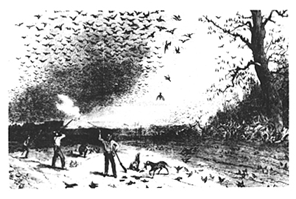|
In all probability, the Passenger Pigeon was once the most abundant bird on the planet. Accounts of its numbers sound like something out of Alfred Hitchcock's The Birds and strain our credulity today. Alexander Wilson, the father of scientific ornithology in America, estimated that one flock consisted of two billion birds. Wilson's rival, John James Audubon, watched a flock pass overhead for three days and estimated that at times more than 300 million pigeons flew by him each hour. Elongated nesting colonies several miles wide could reach a length of forty miles. In these colonies, droppings were thick enough to kill the forest understory. Passenger Pigeons were denizens of the once great deciduous forests of the eastern United States. The birds provided an easily harvested resource for native Americans and early settlers. To obtain dinner in the nesting season one needed only to wander into a colony and pluck some of the fat squabs that had fallen or been knocked from their nests. Audubon wrote in his classic Birds of America, "The pigeons were picked up and piled in heaps, until each [hunter] had as many as he could possibly dispose of, when the hogs were let loose to feed on the remainder."
Market hunters prospered, devising a wide variety of techniques for slaughtering the pigeons and collecting their succulent squabs. Adults were baited with alcohol-soaked grain (which made them drunk and easy to catch), and suffocated by fires of grass or sulfur that were lit below their nests. To attract their brethren, captive pigeons, their eyes sewn shut, were set up as decoys on small perches called stools (which is the origin of the term stool pigeon for one who betrays colleagues). Squabs were knocked from nests with long poles, trees were chopped down or were set on fire to make the squabs jump from nests. Disruption of the colonies was so severe that wholesale nest abandonment was common and breeding success much reduced. So successful were the market hunters that pigeons became cheap enough for use as live targets in shooting galleries. Laws intended to protect the pigeons did not help. In 1886 an editor's note in Forest and Stream said: When the birds appear all the male inhabitants of the neighborhood leave their customary occupations as farmers, bark-peelers, oil-scouts, wildcatters, and tavern loafers, and join in the work of capturing and marketing the game. The Pennsylvania law very plainly forbids the destruction of the pigeons on their nesting grounds, but no one pays any attention to the law, and the nesting birds have been killed by thousands and tens of thousands. As railroads penetrated the upper Middle West after the Civil War, many millions of pigeons were shipped to cities along the Atlantic seaboard, since, by then, clearing of oak and beech forests and hunting had already exterminated the birds on the East Coast. Extinction of the Passenger Pigeon came with stunning rapidity. Michigan was its last stronghold; about three million birds were shipped east from there by a single hunter in 1878. Eleven years later, 1889, the species was extinct in that state. Although small groups of pigeons were held in various places in captivity, efforts to maintain those flocks failed. The last known individual of the species, a female named Martha, died in 1914 in the Cincinnati Zoo and is now on display in the U.S. National Museum of Natural History. Of course, market hunting ended as soon as harvesting the birds was no longer economically profitable. That point was reached when tens of thousands of the birds still flew within large stretches of suitable habitat. Much of that habitat still exists today, although many of the largest nut-producing trees that were common in the heyday of the pigeon were logged. Why, then, did the birds go extinct? No one knows for sure, but it appears that to survive they needed to nest in vast colonies. Perhaps this permitted them to "swamp" predators with their enormous numbers, so that the relatively few predators in the area of a roost were unable to make a significant dent in the huge breeding colonies. And since these colonies dispersed as soon as breeding was over, predators were prevented from building up their populations on the basis of such an ephemeral resource. In any case, the fate of the Passenger Pigeon illustrates a very important principle of conservation biology: it is not always necessary to kill the last pair of a species to force it to extinction. Sad to say, the lesson of the Passenger Pigeon has not been learned. At the present time the White-crowned Pigeon is threatened by the horrendous slaughter of nesting birds on its Caribbean breeding grounds. SEE: Conservation of the California Condor; Island Biogeography; The Decline of Eastern Songbirds. Copyright ® 1988 by Paul R. Ehrlich, David S. Dobkin, and Darryl Wheye. |
